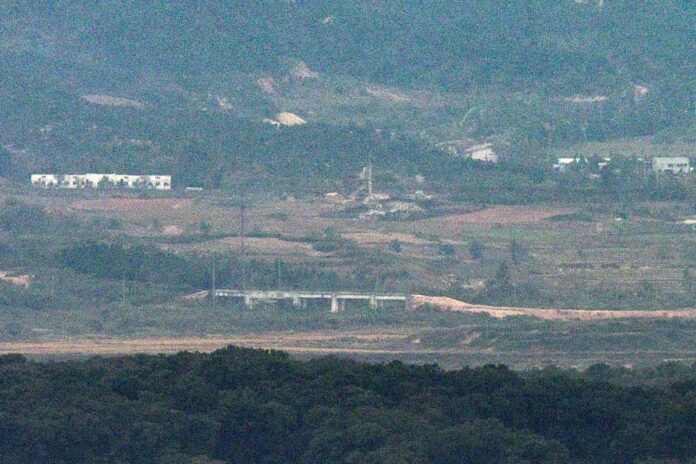
Tensions between North and South Korea escalated sharply on Tuesday as North Korea demolished portions of inter-Korean roads and rail lines along its side of the heavily militarized border. This aggressive move comes amid rising hostility between the two neighbors, both of whom remain technically at war following the unresolved conflict of 1950-53, which ended in an armistice rather than a peace treaty.
The destruction occurred around midday when South Korea’s Joint Chiefs of Staff (JCS) reported that sections of northern roadways and railways connected to the South had been blown up. South Korea responded swiftly by firing warning shots south of the military demarcation line, a key boundary that divides the two Koreas. Although the explosions caused no physical damage on the South’s side, the symbolic destruction of the infrastructure marks a sharp increase in hostilities and further deteriorates the already fragile relations between the two nations.
This aggressive action follows North Korea’s recent pledge to completely sever inter-Korean roads and railways and reinforce its border areas. Just a day prior to the demolition, Seoul had warned that North Korea appeared to be preparing for such an incident. In recent days, the North has been actively installing additional landmines and other barriers along the demilitarized zone (DMZ) and was observed using heavy equipment to bolster its border defenses.
Brief Period Of Reconciliation
These moves are not isolated incidents but rather part of an escalating trend of aggression and deteriorating diplomatic relations. The inter-Korean infrastructure, which includes the roads and railways destroyed by the North, was established during periods of relative détente between the two nations. Notably, it was part of the thaw in relations that followed the 2018 summit between South Korean President Moon Jae-in and North Korean leader Kim Jong Un.
At that time, the two leaders declared the beginning of a new era of peace and vowed that there would be no more war between their countries. The summit led to significant optimism about inter-Korean cooperation, which was reflected in the rebuilding of cross-border infrastructure. South Korea spent an estimated 180 billion won (approximately $132 million) of taxpayers’ money on these projects, according to Yonhap News Agency.
However, this brief period of reconciliation has since unraveled, with North Korea reverting to a more hostile stance. The destruction of the infrastructure marks not only a physical dismantling of a peace symbol but also the end of one of the last vestiges of that period of rapprochement. It highlights the rapid deterioration of inter-Korean relations, which have become increasingly volatile.
North Korea Again Plays The Victim Card
Part of the tension stems from accusations made by North Korea against the South. Pyongyang recently alleged that South Korea had flown drones over the North’s capital, scattering anti-regime leaflets. North Korea claimed that this action was a “political and military provocation” designed to undermine its sovereignty. The regime’s leadership warned that such acts could easily lead to armed conflict.
On Friday, North Korea reported that a “huge number” of these leaflets were dropped by the drones, sparking anger in Pyongyang. In response, South Korea’s Joint Chiefs of Staff declined to comment on whether their military or civilian actors had been involved in any such drone operation.
The destruction of inter-Korean infrastructure is the latest escalation in this long-standing feud. It occurred after North Korean leader Kim Jong Un presided over a high-level meeting with his defense and security officials. During this meeting, Kim discussed how to counter what he termed as the “enemy’s serious provocation” — a reference to the alleged drone incident, which North Korea claims violated its sovereignty.
The state-run Korean Central News Agency (KCNA) reported that this meeting involved strategic discussions on how to respond to these perceived threats from South Korea. This rhetoric is consistent with North Korea’s traditional stance of portraying itself as a victim of foreign aggression, justifying its military actions as defensive measures.
The explosions and subsequent border fortifications have alarmed South Korea, which has increased its surveillance and military readiness in response. The two Koreas are no strangers to military posturing, but the recent developments have raised concerns that this latest escalation could lead to a more serious conflict. The destruction of the inter-Korean roads and rail lines is not just an attack on physical infrastructure but a clear signal from Pyongyang that it is no longer interested in pursuing peaceful cooperation with its southern neighbor.
The events are a stark reminder of the volatile nature of the Korean Peninsula. Despite brief periods of diplomatic engagement, such as the 2018 summit, the longstanding enmity between the two Koreas persists. North Korea’s actions serve as a reminder that it remains deeply suspicious of the South and willing to take dramatic steps to assert its sovereignty and deter what it perceives as provocations. With both sides continuing to prepare for potential conflict, the possibility of further military escalation looms over the region.
